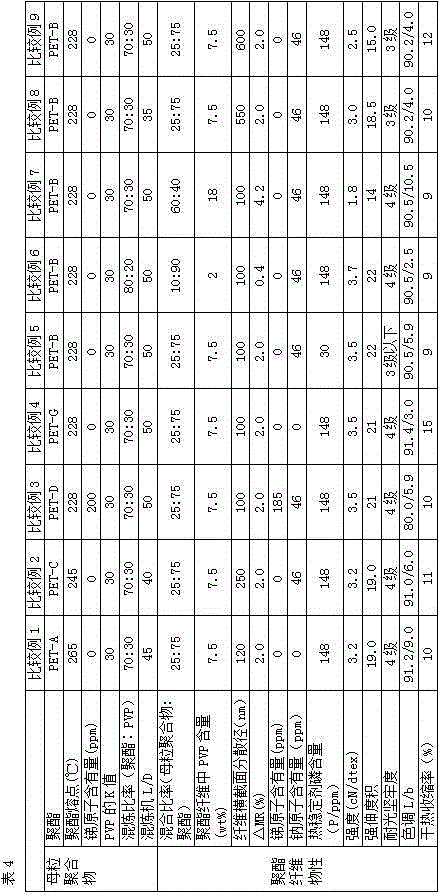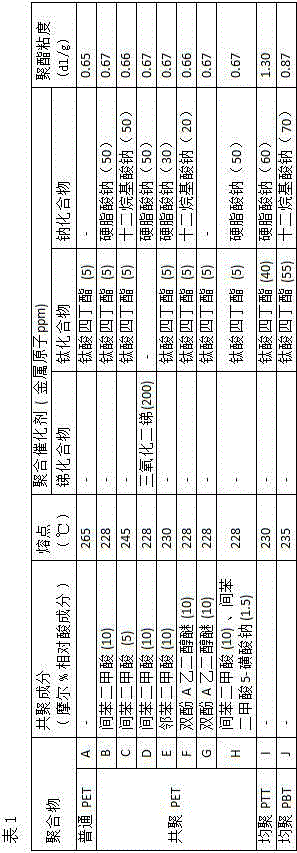Polyester fiber with moisture absorption/desorption performance and preparation method thereof
A polyester fiber, moisture absorption and release technology, applied in the field of hygroscopic polyester fiber and its preparation, can solve the problems of increased thermal shrinkage and difficulty in use, and achieves good light fastness, good color tone, excellent absorption and release. The effect of wet performance
- Summary
- Abstract
- Description
- Claims
- Application Information
AI Technical Summary
Problems solved by technology
Method used
Image
Examples
preparation example Construction
[0043] The present invention also relates to a method for preparing the above-mentioned polyester fiber. In the method, the polyester and poly(N-vinyl lactam) are firstly mixed in a weight ratio of 95:5 to 60:40, and the screw length-to-diameter ratio L / D is used. Melt and knead in a twin-screw extruder above 40 to obtain a masterbatch polymer.
[0044] Poly N-vinyllactam with an average dispersion diameter of less than 500nm can be well complexed with polyester fibers, thereby inhibiting the dissolution of poly N-vinyllactam and preventing polyester fibers from The hygroscopicity of the polyester fiber is reduced, and the moisture absorption durability of the polyester fiber is improved. In the present invention, it is preferable that the average dispersion diameter of the poly-N-vinyllactam is not more than 300 nm, more preferably not more than 150 nm.
[0045] In order to keep the average dispersion diameter of poly-N-vinyllactam below 500 nm, the twin-screw extruder used ...
manufacture example 1
[0080] [Manufacturing example 1]
[0081] 784 g of ethylene glycol and 1,324 g of terephthalic acid were subjected to esterification reaction, followed by polycondensation reaction. First, put all the terephthalic acid, 533g of ethylene glycol, and 0.88g of tetrabutyl titanate into the reactor with a rectification tower, and start the esterification reaction at a temperature of 250°C and a vacuum of 400mmHg. While slowly raising the temperature, the residual ethylene glycol was added continuously. Then move to polycondensation reaction tank, carry out polymerization reaction under vacuum condition and temperature 285 ℃.
manufacture example 2
[0082] [Production Example 2]
[0083] Ethylene glycol 784g? Terephthalic acid 993g? Isophthalic acid 331g, sodium stearate nucleating agent for esterification reaction, followed by polycondensation reaction? First all the terephthalic acid and isophthalic acid , Sodium-based nucleating agent? Ethylene glycol 533g? Calcium acetate 1.2g? Tetrabutyl titanate 0.88g into the reactor with a rectification tower, the temperature was raised from 130°C to 235°C for 3 hours, and then moved to polycondensation In the reactor, the temperature was raised from 240°C to 285°C under vacuum for post-condensation reaction for 4 hours?
PUM
| Property | Measurement | Unit |
|---|---|---|
| melting point | aaaaa | aaaaa |
| shrinkage | aaaaa | aaaaa |
| aspect ratio | aaaaa | aaaaa |
Abstract
Description
Claims
Application Information
 Login to View More
Login to View More - R&D
- Intellectual Property
- Life Sciences
- Materials
- Tech Scout
- Unparalleled Data Quality
- Higher Quality Content
- 60% Fewer Hallucinations
Browse by: Latest US Patents, China's latest patents, Technical Efficacy Thesaurus, Application Domain, Technology Topic, Popular Technical Reports.
© 2025 PatSnap. All rights reserved.Legal|Privacy policy|Modern Slavery Act Transparency Statement|Sitemap|About US| Contact US: help@patsnap.com



